All-natural fruit tree “bait” jugs for insects: they work!
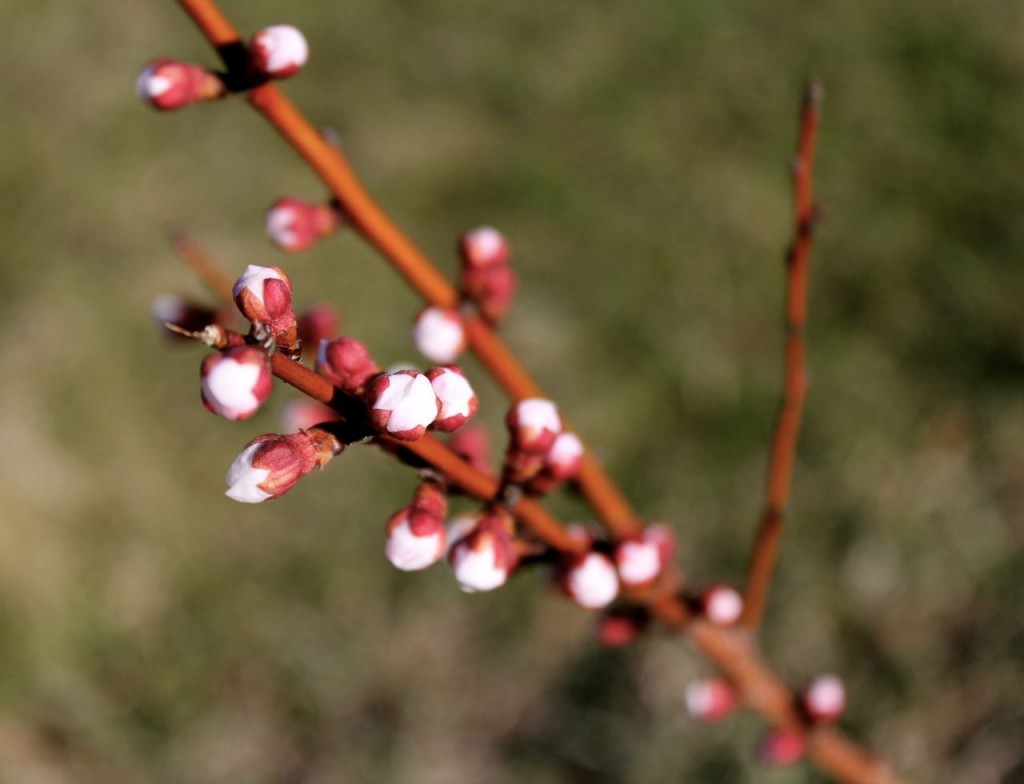
such tender and beautiful buds!
This post was updated just for you, Gentle, fruit-growing Reader, in August 2019. Treat your fruit trees to all-natural bait jugs that will attract (and drown) problematic insects.
The Delight of your own orchard
We planted a small orchard on our place about ten years ago and were delighted when it started to produce fruit a few years ago. Being able to walk out to your own orchard and harvest delicious fruit is an experience everybody ought to have! Even one or two trees can be planted on a small city plot. But we learned that we needed to do something to catch the multitudes of pests that came after our fruit.
The Dismay of wormy fruit
Our delight quickly turned to dismay, however, when we discovered that much of our lovely fruit was wormy! Most of the damage, we learned, was the work of the common and infamous codling moth, admittedly a rather attractive moth but not one that you want to hang around your fruit trees.
Or befoul and completely ruin your hard-won orchard fruit.
A plethora of pests
There are a large number of pests–crawling, burrowing, wandering, and flying ones–that will harbor ruinous thoughts toward your efforts to grow beautiful fruit. Deer will wander in at night and eat the bark off the trees, harming and even killing young trees; rabbits and voles will burrow underneath and dine on roots; and then there are the insects. There are so many, but I’m going to be addressing making all-natural bait jugs to hang in your fruit trees today for the one that does the most damage to my fruit.
It’s the dreaded cydia pomonella, or the cunning, greedy codling moth.
The codling moth (cydia pomonella) is a pest that is common all over the world, though it was native to Europe originally. The larva of the moth is the common apple worm or maggot. The little bugger will also attack pears, walnuts, and other tree fruits.
Question: But why don’t you just spray–?
Spraying fruit trees with a chemical spray several times throughout the growing season is generally believed to be the only way to repel the insects that do the most damage to the fruit in our area. I actually bought some spray a few years ago. I was so determined to have bug-free fruit.
Reading the warnings on the back of the bottle scared me away from using it, though.
“HAZARDS TO HUMANS AND DOMESTIC ANIMALS! Causes substantial but temporary eye injury. Causes skin irritation. Harmful if inhaled or swallowed. Do not get in eyes, on skin or on clothing. . . BEE CAUTION: MAY KILL HONEYBEES OR OTHER BEES. This product is very toxic to honeybees!”
Yikes! That’s not all. The warnings go on at some length, but that was enough for me to put the bottle of spray aside and think hard about whether I wanted to risk it or not. I never did pick it up again. (I love our honeybees and song birds!)
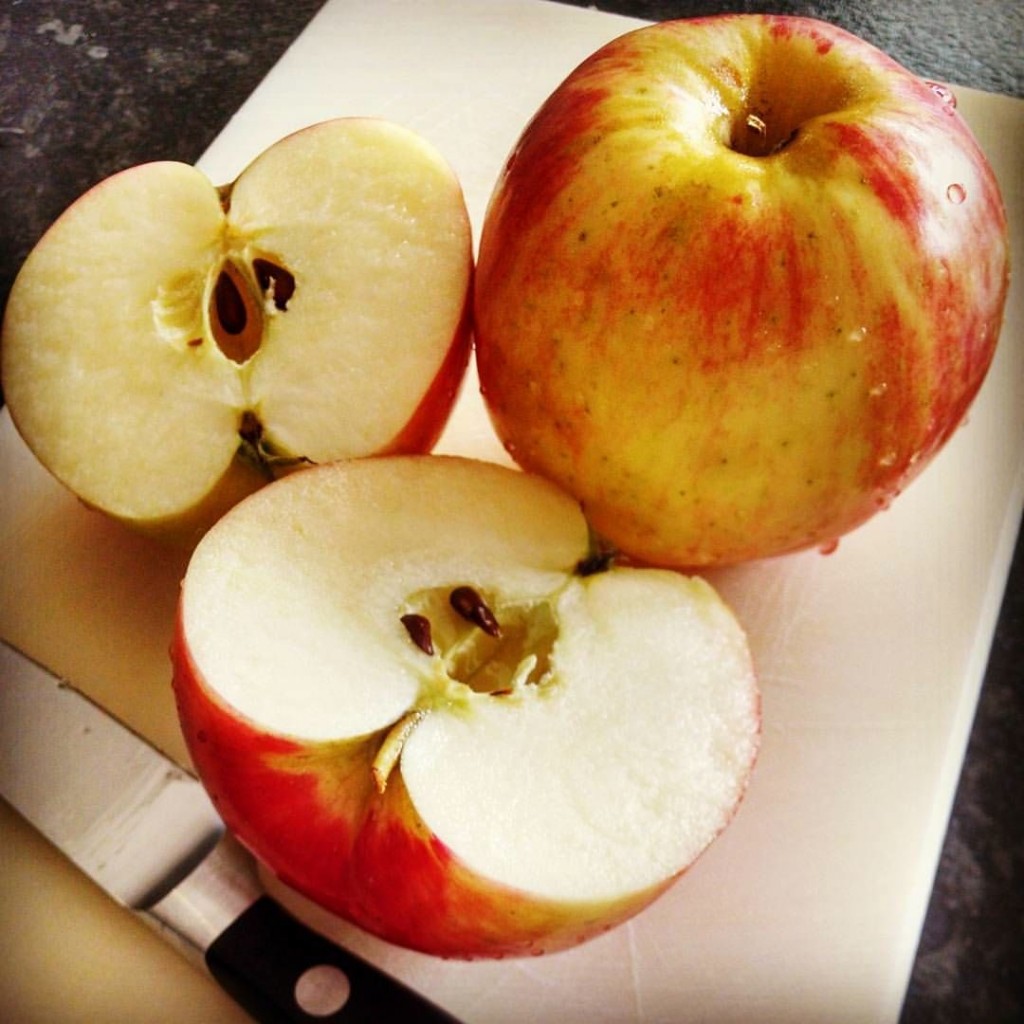
This is what you want! Beautiful, insect-damage-free fruit!
Healthy honeybees and songbirds
We spend quite a bit of time and energy trying to keep our honeybees healthy and to attract songbirds to our place: I wouldn’t want to do anything that would harm them or drive them away. And of course my spoiled chickens have the run of our place most of the time, as well.
I have oodles of good reasons to avoid using chemical insect controls on our place. Oodles!!
However, it’s not much fun to eat wormy fruit. Happily–amazingly–a couple of years ago, I discovered a natural way to keep the nasty bugs away from my fruit. This method is very easy to do, and uses supplies that you probably have in your kitchen right now.
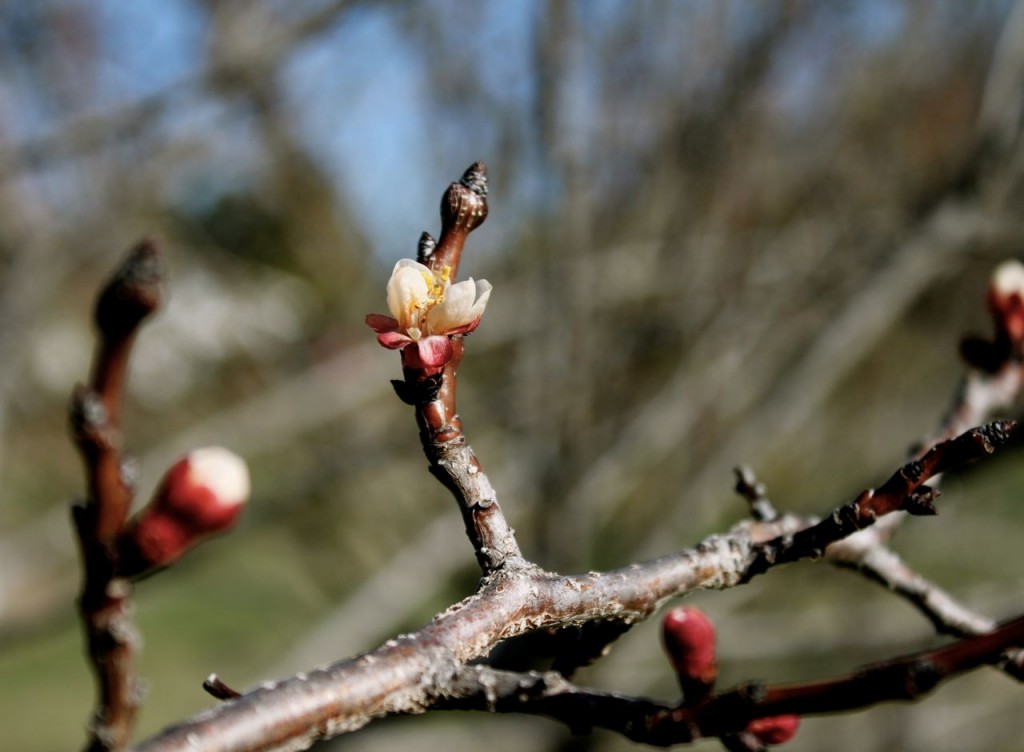
It’s very simple; it doesn’t cost much; it won’t hurt your songbirds, your children, your dog or your honeybees; and it has been very effective in my own orchard, even last year which was unusually hot, dry and buggy.
If you have fruit trees and are put off by the chemical spray route, and if the codling moth or other insects have made your fruit nearly impossible to enjoy, you may want to try this also.
The answer to the problem: all-natural bait jugs for insects
Here are the things you’ll need, for each tree you have, and if your trees are quite large you might want to double up.
- Gallon-size plastic jug (milk jugs are good, vinegar jugs–which are tougher–are even better. 2-liter pop bottles are tough and can be used too, but they don’t have that handy handle)
- Sturdy twine or rope
- a sharp knife or sturdy pair of scissors
- 1 cup white vinegar
- 1 cup sugar
- 1 cup water
- 2 banana peels, cut in strips (I’ve substituted other fruit peels when we didn’t have bananas in the house, and they seemed to work just as well)
And here’s how you make your all-natural bait jugs to catch those insects:
- Slice off a third of the top of the gallon jug (leave the handle intact) and punch a few holes along the top edge. Thread a 2′(ish) length of twine through handle and holes.
- Mix together the sugar and vinegar, and put into the jug. Add the banana strips.
- Add the water to the solution and stir vigorously.
- Hang the jug in your fruit tree.
- Check the jug every day or two for moths, and replace with new solution when necessary. If you have codling moths in your area (and you probably do) when they are most active your solution will be positively full of dead moths on a daily basis. It’s pretty thrilling, really. If the jugs fill up with moths too quickly, I’ll double the recipe so I don’t have to change the solution so often. I have other things going on too, after all. 🙂
You must get the timing right
Three years ago when I hung these jugs in my orchard for the first time, I must have hit the timing just right, because the next day when I went out to check on the jugs, every single one was so full of dead moths that I couldn’t even see the solution. I delightedly dumped them all into the compost pile and refilled them with new solution. I had to do this a few times during the first week or two, but my apples that year were nearly free of moth damage and worms.
It took just a little bit of time and attention, but the rewards were huge!
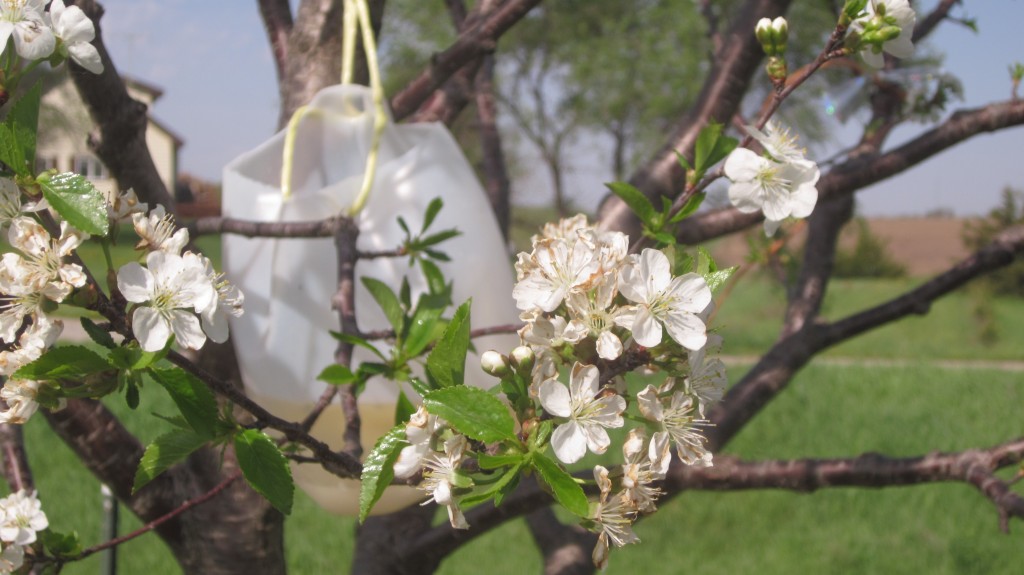
The gallon jugs don’t show up that much, nestled into the fruit trees like this. Look at all the pretty blossoms on this apple tree! Hooray!
Having all those lovely apples was even more thrilling than finding all the dead moths in the traps!
How lucky we are that the Cydia Pomonella doesn’t know the back stroke.
When to hang the jugs is very important!
If you want to try this for yourself, it’s important to get those jugs full of solution into your fruit trees before they bloom, or at least as the blooms are opening, as that’s when the codling moth seems to begin laying eggs. What happens is that the moth is attracted to the vinegar-sugar solution with the fruit peels, and then drowns in it, thus not laying its eggs on the leaves and blossoms of the fruit tree.
A Book you must have:
By the way. I just bought this book and am currently–wide-eyed–working my way through it. I highly, highly recommend it to you if you are growing an orchard and care about doing it right. It’s an awesome book.
We installed the jugs in our orchard trees this week, and I’m checking them every day or two for moths. My trees are blossoming beautifully this spring, so I’m looking forward to lots of delicious, chemical-free fruit this summer!
So now, Gentle Reader, if you have fruit trees and have been perplexed by the damage of coddling moths or other baffling insects in the past . . . well. . . . now you know what to do!
Pin it for later
And if you’d do me and your friends the favor of sharing this post with them, we’d all be in debt to you–because–who doesn’t want better fruit from their fruit trees? (And thank you!)
*hugs*


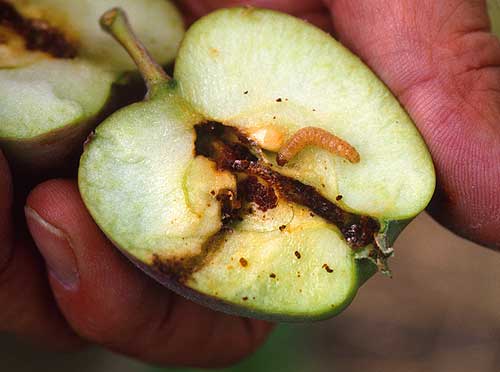
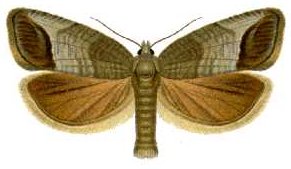

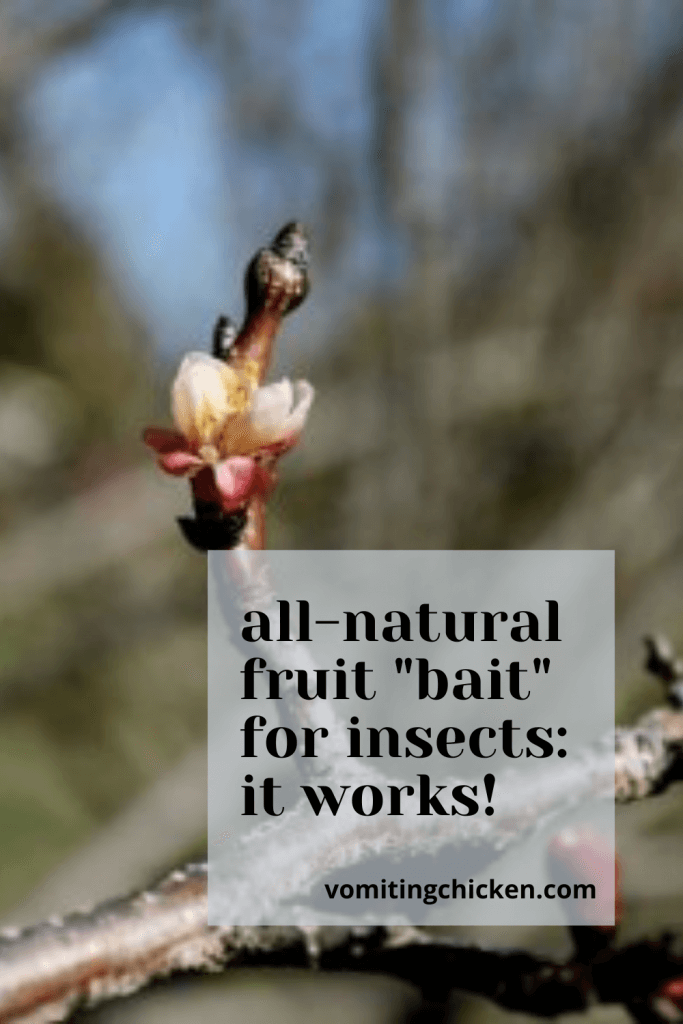
Good luck…
Although I don’t have fruit trees, this sounds like an easy solution- I tweeted it and pinned it on my Gardening board to help out fellow gardeners. Thank you.
Thanks so much for sharing, Alana!
What a fabulous blog and a great solution to a rather nasty addition to your fruit.
Thanks Anita-Clare!
Wow – amazing idea, Amy! I am so impressed by the versatility of vinegar!! Seriously, the stuff is great! Thanks for sharing, Carrie
You’re right, Carrie, vinegar is really amazing–and, (miraculously) it’s cheap, too!
We don’t have fruit trees…but black walnut’s FILLED with carpenter ants – quite possibly my least favourite insect on earth (home invaders) – will it work for them?
I love you posts!!
Sara,
I don’t know if it would work with the carpenter ants, but it wouldn’t hurt to try! If you try it, I’d like to hear if it helps or not, if you don’t mind?
What a great tip. Much better than poisoning your friends and family. 😉 Eat well.
Thanks Francene!
This was so informative. I will come back when my fruit trees start to produce. Thank you for the great info!
I’ll have to pass this on to some friends that have fruit trees. They are always looking for chemical free solutions. I don’t think I’d fancy finding those little worms in my food either!
Please do! I hope it helps!
I think we’ll have to try this. Our trees are finally getting big enough to actually produce something.
Jamie,
I’ve found that it works as long as you get it out there when the blossoming begins. Let me know how it works for you!
Will be making this! I use a similar solution in the house with a drop of dish soap for fruit flies. I put in my first apple trees this year and they have just started to bloom.
We have a small peach tree with lots of blossoms. We are going to try your solution. How many containers do you put in a small tree? Last year our peaches had speckles all over the and on their leaves to. We have a apple tree too.
Good luck with it, Shirl! In a small tree, I’d only use one jug.
Keep in mind that what you are describing may not be insects at all, but a bacterial spot disease: http://msue.anr.msu.edu/news/management_of_bacterial_spot_on_peaches_and_nectarines
In which case, the jugs may not do any good, but they won’t hurt! They are more helpful against the coddling moth that will bother your apples.
Thank you for the information. I believe our apple and peach tree do have the spot bacterial disease.
Isn’t it amazing, Shirl, how much you can learn from a simple Google search?? Really astonishing.
I guess I am probably too late to do it this year, but making a note of it for next spring! How long do you leave it in the tree?
Thanks!
Janet, I leave the buckets in the tree most of the summer, because I’m lazy and don’t want to take them out. I only put the solution in them until the apples are fully formed, though, and the coddling moths have moved on.
Thank you!
Amy, I wish I had seen this a month ago, when peach and plum trees started blossoming in Texas. Thanks — I will save the advice in my January calendar!
Do you think it will work for cherry trees that get worms? There are already blossoms also but I could put one out there right now!
Leah, it might help! I do put these in my cherry trees every spring and my cherries are usually clean. I do find an occasional worm.
Thanks for the info, Amy. I have apple, pear peach and cherry trees that should finally be giving fruit this year. I’ve already cleared and squished two tents full of tiny caterpillars. I was hesitant to spray with chemicals, and you’ve convinced me not to. We have a healthy bee population in our yard, and I’m not going to do anything to jeopardize their safety.
Greg, at this point in my life–and in the distress of the environment–I’d venture to say that the honeybees are more important than the fruit itself. You can still buy fruit at the store or the market, after all. The farmers in my area have become so adept at killing insects on their crops that we have very few bees. And our hives die nearly every winter, for one reason or another. It’s very distressing. I appreciation your efforts to keep the bees in your area safe from harm.
The honey bees are not attracted to the sugar mixture? We have 3 hives and are very cautious about spraying the blossoms of our fruit tress with anything, including neem oil. This sounds like a great idea as long as it does not attract the honey bees too.
Onalee, I’d use caution . . but I’ve never noticed more than the odd bee or two in my buckets of sugar mixture. I think the thing is that when it’s in the trees, the trees are full of blossoms, and the bees are really super-busy in those blossoms. I suppose it’s a timing thing.
I wish I saw this solution a week or two before the apple blossoms. My very productive appke tree dropped all the petals and I can see the crowdy tiby apples now. Do you think I xan still use it on the tree effectively? I also have a pear tree which is dropping the petals.. I want to use on it too.
Zerrin,
The vinegar-banana peel–sugar solution won’t hurt anything, but after the petals drop, it’s too late to catch the coddling moth. You would catch other insects, though, that might do harm to your fruit, so it wouldn’t hurt to put it out.
I use this on my orchard, but I don’t cut the tops of the milk jugs at all. Insects fly in, but can’t get out as easily. Also I can leave them out in a storm and they don’t take on any water. I tie them with a loose knot to the branches with wide strips of fabric (old sheets work well). I use 4 milk gallon jugs per grown tree. I missed changing the solution for several weeks, but they were STILL catching moths and other insects. I only use 3 Tablespoons of sugar and vinegar each, and then fill the jug 1/3 full with water and swish to mix. This method catches TONS of pests! And is a whole lot cheaper than other methods!
Kathy, you’ve just won an Best Gentle Reader award for adding such a valuable tip to my post! I’m going to add your tip to this post. One thing that I’ve been frustrated by, in my method, is that it has to be refreshed (or replaced) so often. Your additions–leaving the tops on the milk jugs, adding more water, etc., will help with this problem. Brilliant. Thank you!!
Thank-you Amy! I’m going to keep mine on all summer, as they recommend treating with chemicals for coddling moths till harvest. (I was going to take them down this week, but I’m still catching lots of moths!) P.S. I also don’t use any fruit peels (saves more money) and it works wonderfully !
Kathy, I certainly owe you for sharing your experience with me! Thank you!
Coddling moths don’t lay in cherries. Cherry flies do, anx they do it just as the fruit is starting to blush. Sweetened vinegar may attract cherry flies, too, but if you want a 100% worm-free cherry crop, the best non-toxic solution is to cover the trees, after pollination and before the fruit begins to ripen, with cloth whose weave is small enough to keep the tiny cherry flies out, yet permeable to air, sun, and water. Check out kootenaycovers.com, a 100% solution.
Thank you for this Deborah!
Do you put a jug with this mixture in each tree? I love the idea of not using chemicals!
Lindsey, yes, and in larger trees, I’ll put two.
Hi Amy,
I have several peach trees. Every year there is are large clumps of clear hard sticky goo that oozes out of them and ruins them all. I’m not sure what causes it. I’ve tried researching. I’m not sure if it’s an oriental fruit moth. Any ideas or experience? I really need a solution!
Shelly, Do an internet search for “stone fruit tree borer.” Nearly all stone fruit trees are susceptible to this pest, and it will kill them all eventually. There is a preventative. I haven’t done a post on it yet, but I plan to. Good luck!
And this doesnt attract bees and other helpful pollinators?
It has not, in my experience, at least.
Hi Amy. My sister in law tipped me onto trying this-she has been doing it for a couple of years. She uses just vinegar, sugar and banana peels-no water. We have sprayed our trees twice this year already with a chemical spray. We have used the same thing in the past with varying results-anywhere from 20-50% of the fruit being infested. Spraying is such a pain because you have to wait for the weather to be just right, too. I would love to start doing this but am wondering if hanging jugs out now will do any good or should we wait till next spring to try this?
Hi Sue! It won’t HURT, but in my experience it’s better to hang the jugs out in the spring when the trees are blooming. That’s when many of the pests become a problem.
Oh, my. Thanks for this information. I am going to give this a try this year, as our last year’s crop of apples were severely damaged by insects. I will also buy some Tanglefoot, in the hopes that I can deter any crawling insects.
Probably it would be best to use more than one defence, Jeanette!
Hi. Just a comment about the comments. I see that they come in reverse order; i.e., the first one is the oldest. Would it be better to have the new comments first? Not every one reads all the way through, and a comment made in 2019, say, is perhaps more valuable to someone that a comment made in 2013. Just wondering.
Good point, Jeanette. I don’t know if it would be possible to change it, but I’ll check into that. Thanks!
I am wondering if using overripe fruit instead of just the peels would work as well. I have some berries and apples I was wondering if they would work.
I’ve used apple peels before, Janet, and they seemed to attract the bugs too.
Thank you for the post, but it seems I’m too late in Michigan, as we already have fruit on the trees. I will save this for next year, and try an all natural spray to prevent infestation.
Do I leave the jugs on the tree throughout the whole growing season or just before the trees blossom?
Mary, I think it’s just easier to leave them in place!
Wonderful tips. I have been using a similar milk jug trap: 1 cup vinegar, 1/4 cup molasses, 1/8 teaspoon ammonia, and 5 cups of water per jug, but have never known when to put them out. Once again, it appears I am too late (I have been waiting for the apples to appear first!) but will put them out anyway. I will try your recipe in some to see which one works best. I also Love the thought of simply leaving them in the trees year round and filling in spring. Thank you
Yes, Maggie, I didn’t get mine out this year in time, either. Busy spring!
My trees of course have already bloomed and I have small apples on them is it to late to do this process ?
Tammy, you may not catch some bugs, but you will catch others. If you have the time and inclination, go ahead and put them up. There are a lot of pests that are attracted to them!
Thank you for this article. I hope it is ok that I have shared it with fellow gardeners.
Teresa,
of course! Share away!!
Wondering if lemon peel, orange peel, apple peel or slices would work on my apple trees to keep bugs out. Or better off using bandana peel?
I think the apple peel or slices would work fine, but the lemon and orange peel wouldn’t degrade and attract the bugs. I wouldn’t try them, personally. Good luck!
I am wondering if it matters how early to put out the jugs? I am thinking about it/have time right now so would like to put them out now but our trees are just started to bud. Any harm in doing it early?
Thanks!
Alissa, no there’s no harm in putting the jugs out early. Just check them often and replace the contents if they a. get rained in, b. get full of bugs! Good luck! And may I add–better early than too late!
Would this solution work on any other type of bugs? We have a lot of beetles in our apple tree and really would like to get rid of them. We just moved here at the end of April, so we had no idea that this was a problem at the time.
It would be very easy to find out! Put out a jug with this solution and see if it attracts any bugs! Might be worth the experiment!
This says white vinegar. I’m sure ours used apple cider vinegar. Why white vinegar instead of cider vinegar?
Either type of vinegar will work fine! I probably originally specified white vinegar because I can buy it cheaper here than apple cider vinegar.
Please put me on your email list! Planting fruit trees this spring
Done! Good luck with those fruit trees!
Please add me to your email list. I have just planted my first fruit trees ever, so I am trying to learn all I can, lol! Do you put this solution on new trees? Mine are probably 6 ft tall and are blooming….but still have kind of spindly branches. Thanks!
I will add you to my email list, thanks!
If there are blossoms, I will hang the jugs with the bait. The blossoms will probably lead to fruit! Good luck!